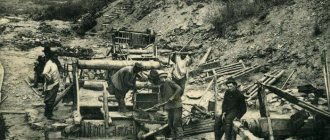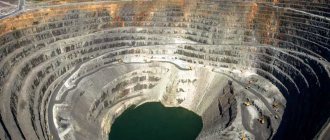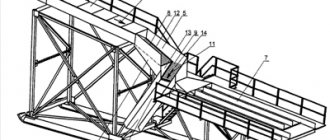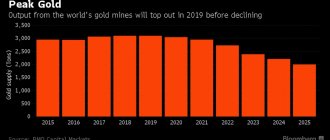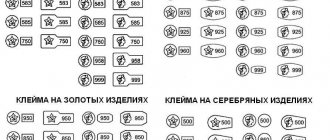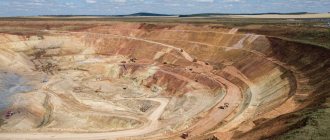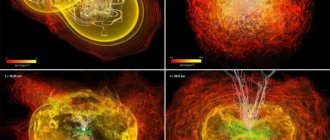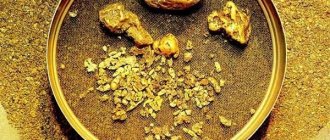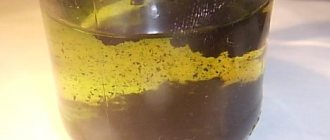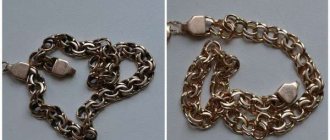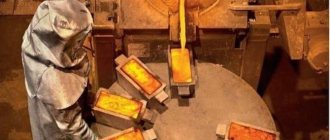Gold is one of the oldest human satellite metals. Since ancient times, it has served people as decoration, a universal means of payment, and an indicator of their social status. The explored world reserves of gold today, according to preliminary information, are about 55 thousand tons. In reality, there is incomparably more gold, if we take into account the gold reserves at the bottom of the World Ocean. What types of gold deposits exist and how gold is extracted from them, you will learn in this article.
Types of gold deposits
There are two main types of deposits:
Primary or primary deposits alluvial or secondary deposits formed from them
Formation of primary gold deposits
The formation of primary deposits is associated with magmatic processes. The Earth's magma, unlike the crust, contains an increased concentration of gold. As a result of volcanic activity, streams of magma burst to the surface.
Magma is a melt of various compounds, the melting points of which vary greatly. After breaking through to the surface, the magma begins to cool. The first to crystallize are refractory substances, which at sufficiently high temperatures turn into a solid state. However, a moving mass of more fusible compounds continues to circulate inside the frozen mass. Through faults and cracks in the cooled magma, this melt shoots into the surrounding rock, forming veins. The veins have a variety of shapes, structures and sizes, going several kilometers deep into the earth. Inside them, in turn, hot solutions of salts containing gold, formed from steam, circulate. As a result, when completely cooled, the salts are destroyed and the gold crystallizes inside the vein in almost pure form.
It should be understood that when magma is released and cools, a huge number of different reactions occur. They involve both substances of the magma itself, and minerals from the rocks of the earth’s crust that host the magma, as well as water. The course of the process and the final composition of the compounds resulting from the complete cooling of the magma may vary. Thus, primary gold deposits can be formed in several ways, but they are always associated with igneous rocks.
The main mineral of most veins is quartz or silicon oxide (SiO2), less often - calcite, albite, barite, chlorite, sericite, tourmaline, chalcedony. In addition, a significant part of gold-bearing ores is formed by sulfur compounds of metals:
- iron - pyrite or iron pyrite (FeS2), arsenopyrite or arsenic pyrite (FeAsS), pyrrhotite (most often Fe6S7);
— lead — galena or lead sulfide (PbS);
– copper – chalcopyrite or copper pyrite (CuFeS2)
- zinc - sphalerite or zinc sulfide (ZnS).
Gold in primary deposits rarely exists in its pure form. It usually contains some amount of other metals. The majority of impurities are alloys with copper and silver. There are also deposits in which gold contains platinum and other platinum group metals.
Part of the gold is extracted as an associated metal during the development of deposits of copper, zinc, lead, silver, platinum group metals and nickel.
In general terms, primary gold deposits were formed in zones of magmatic activity, namely in the mountains.
Formation of secondary gold deposits
Rocks containing primary gold formations were subjected to continuous physical and chemical attack, which led to their destruction. Temperature changes, weathering, precipitation and groundwater, the action of microorganisms and plants - all this leads to the gradual destruction of rocks. As the rocks break down, they release the gold they contain. It begins its long journey from the mountains down to the valley, forming secondary or placer deposits.
Water plays a major role in the movement of gold. It gradually erodes mountain ranges, carrying down pieces of rock, transforming, crushing and grinding them. Gold, due to its inertness, does not react with water or any other substances; it remains unchanged.
We owe the formation of placer deposits to another of the main properties of gold - its unique density or heaviness. Since gold is one of the heaviest metals, it tends to accumulate or be deposited in places where lighter compounds are washed away by water. While the gold is contained within the minerals surrounding it in the primary deposit, it moves downward fairly quickly. However, along the way, the minerals are crushed and ground down, gradually releasing gold. After release, gold, due to its gravity, cannot be carried far by the current of water and settles in places where the relief forms various types of obstacles in the path of water.
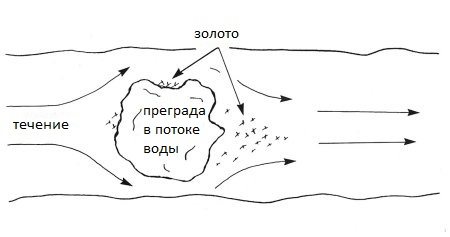
Placer deposits are very diverse in size, method and area of formation. The natural landscape has changed repeatedly over the past millennia - rivers appeared and disappeared, glaciers advanced and retreated, sea levels changed, mountains were destroyed. Often, no trace remains of the original deposit, and the gold from it forms a placer over a considerable distance. A rich placer is not necessarily formed from a rich vein; gold is sometimes carried to one place from several veins. Over time, secondary deposits can also be destroyed, gold from them migrates and forms new placers.
Placer gold is usually easily accessible and does not have to be mined from hard ore as in primary deposits. At the dawn of mankind, the first discoveries of gold were made, most likely, in alluvial deposits - in the beds and along the banks of streams and small rivers, people found small nuggets of metal with amazing properties.
Content:
- Where is gold used nowadays?
- Types of gold deposits
- Indigenous gold deposits
- Gold placers
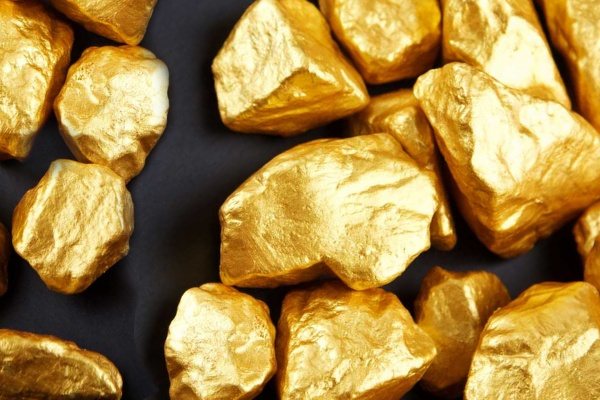
Nowadays, gold is used in the following areas:
Jewelry - approximately half of the gold mined is spent on the manufacture of products; Capitalization of reputable banking organizations - part of the reserves of reputable financial organizations is stored in gold bullion; industry - for radio electronics, dental prosthetics, equipment and equipment for spacecraft, in the manufacture of devices that are subject to increased requirements for their accuracy and durability; investment - the stable rise in price of gold makes it a profitable investment.

What types of gold deposits are currently in use?
According to experts, from the 19th century to the present, more than 85% of all gold since the beginning of history has been mined. For example, in the entire Roman Empire in the 2nd-3rd centuries, about 8 tons of gold were mined per year. Nowadays, in Russia alone, annual production is more than 200 tons.
Until the 20th century, mining was carried out from both placer and bedrock deposits. Efforts to find gold have focused largely on finding placer deposits, since gold is much easier to obtain from them.
However, at the end of the 19th and beginning of the 20th century, with the advent of technologies for effectively extracting gold from ore, active exploration of primary deposits began. About 60% of the gold mined throughout history occurs in the 20th and our 21st centuries. During this period, gold is extracted mainly from primary deposits.
In addition, reserves of readily available placer gold around the world have been steadily declining. Gold remains mostly in primary deposits, the costs of development of which are much higher.
Currently, global gold production from alluvial deposits is about 7%. In Russia, this number is higher than the global one - about 20%, but also tends to decrease.
Metamorphosed deposits
This type of deposit occupies a special place in gold mining. The fact is that primary gold deposits in some cases are capable of changing their properties, helping to increase the concentration and purity of the precious metal.
Deposits become metamorphosed under the influence of physical and chemical processes such as increased pressure, increased temperature, tectonic deformations, etc.
According to the results of modern research, some deposits that were considered “ordinary” are actually metamorphosed, and they are much more common than previously thought.
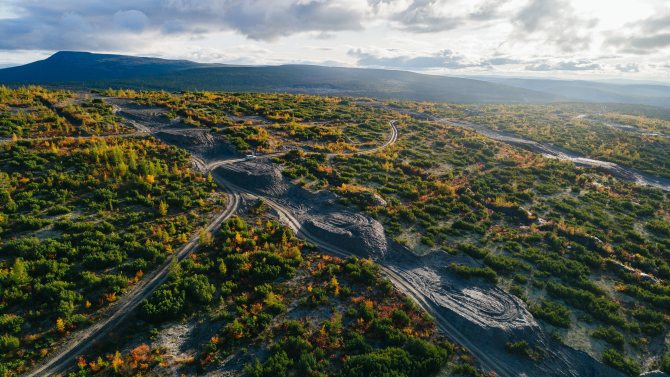
Sukhoi Log deposit. Photo: polyus.com
Metamorphosed deposits, as a rule, contain the largest reserves of gold. In Russia, this species includes Kochkarskoye (Ural), Sukhoi Log (Irkutsk region), Sovetskoye (Yenisei Ridge), Zun-Kholbinskoye (Eastern Siberia), as well as an ore cluster in Yakutia.
Exploration and evaluation of gold deposits
Reservoir exploration is a very complex task. There are no accurate indicators of the presence of gold in rocks. All the minerals most often found together with gold (quartz, pyrites, etc.) in nature are basically “empty”. There is also no clear link between gold and any other elements. Each area is characterized by its own “set” of gold satellites and its own gold-bearing rocks.
Perhaps the only exception is silver. It always accompanies gold. There is a curious relationship - there is little gold in silver-rich deposits. Rich gold deposits, in turn, contain little silver. A natural alloy of native silver containing up to 10% gold is called kustelite. A natural alloy of gold and silver, in which the share of silver is more than 25%, is called electrum.
Knowing the characteristics of a particular territory, based on a complex combination of various features, one can only assume the presence of gold. The discovery of deposits in our time is associated with deep knowledge of geology, modern methods of exploration and research, experience and observation of geologists. We can say that finding gold is a real art.
More complex than exploration is assessing the economic prospects for developing a field. It should be noted that the percentage of gold content calculated as grams/tonne of ore in deposits (both exploited and undeveloped) is trending downward around the world. This means that gold has to be extracted from increasingly poorer ores. In this regard, the development of complex deposits in which other minerals are mined along with gold, or vice versa, in which gold is a secondary product of extraction, is becoming increasingly important.
In order to estimate the total gold reserves, the size and shape of the deposit, a huge amount of mining and drilling work, many samples and calculations are required.
Thus, modern exploration and evaluation of gold deposits is an expensive and labor-intensive process.
Cartography to help
Persistent rumors that there is gold in the Moscow region and that it is not so difficult to find it received unexpected confirmation from cartographers. Not long ago, a modern map of attractions located in the Moscow region was published. The attentive eyes of fortune hunters saw on it the symbol Au between two villages of the Dmitrov region.
One of them is Protasovo, and the second is Ignatovo. Any high school student knows that a similar sign denotes an element of the periodic table, which has atomic number 79 and is a noble metal, or, more simply, gold.
For gold mining in the Moscow region, a map indicating deposits where there is at least any significant amount of gold sand is simply necessary for the prospector. It helps to weed out rumors and legends that have no basis, and direct your energy to finding truly promising places for mining the precious metal.

